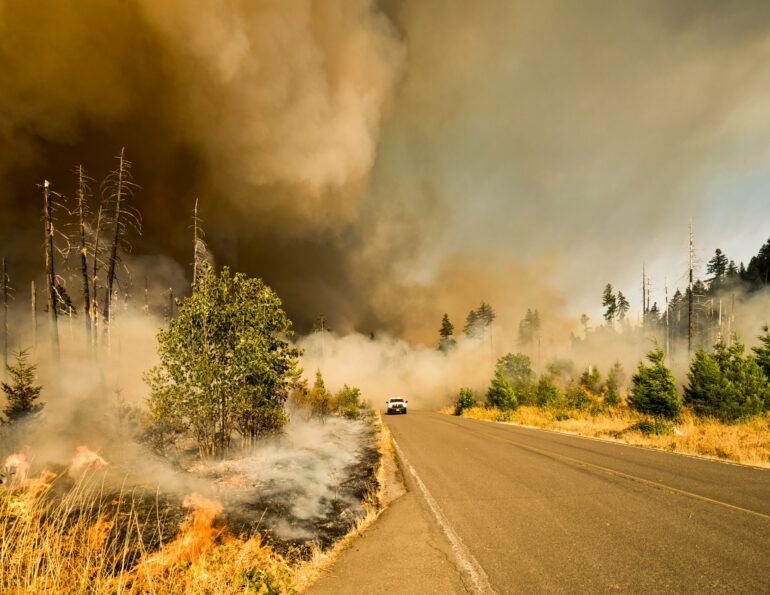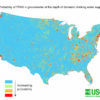In the summer of 2020, wildfire smoke blanketed the city of Portland, Oregon, leading to a prolonged period of poor air quality and health concerns for residents. Subsequently, in 2021 the city experienced a heat wave with temperatures reaching as high as 116 degrees. These events highlighted how the climate crisis has increased the frequency and intensity of wildfires and weather-related emergencies in the western United States.
Already, Oregon has seen a big jump in the number of fires from last year.
At Portland State University, researchers are working to increase wildfire awareness, prevention and mitigation in the Pacific Northwest. Max Nielsen-Pincus, Cody Evers (Environmental Science and Management), Brianne Suldovsky (Communication) and Jonathan Fink (Geology) are all undertaking this effort from different angles, which fits the complexity of the issue: A variety of stakeholders and interconnected agencies work on wildfire mitigation in local, state, tribal, and national governments.
One of the challenges, as associate professor Max Nielsen-Pincus put it, is “building bridges between the different agencies.”
To this end, Jonathan Fink (volcanologist and professor of geology) started the Cascadia Wildfire and Urban Smoke Working Group in 2019.
This informal working group includes researchers, policy experts and technologists from the Pacific Northwest in both the US and Canada. So far, they have held 113 webinars on topics ranging from forest regeneration to the health effects of wildfire smoke. Recordings of the webinars are all publicly available.
The group also held an online symposium, “Wildfire Knows No Borders,” in the fall of 2020.
In the Spring 2024 term, Fink taught a course in the PSU Honors College on wildfire and smoke in the Pacific Northwest. Undergraduate students watched videos from the webinar series and wrote up questions about the videos, then Fink invited the original speakers to join the class to talk about the students’ questions.
This served to further students’ understanding of environmental hazards as well as let them meet with professionals and learn more about careers in science.
“Part of this project is getting people to realize that Portland, Seattle and Vancouver are particularly vulnerable to wildfire,” Fink said.
“Even though we haven’t had major fires in the cities, if you look at tree ring data, there are huge fires that basically go through the entire basin and destroy all the trees, every three to six hundred years. Then the forest gets restarted. It’s kind of like the big earthquakes that happen here, every two to five hundred years.”
One of the takeaways from Fink’s webinar series is that city and county governments and other agencies need to be prepared for fires coming into the city. That could happen in Portland, Fink said, after an extended summer drought followed by winds blowing from the east, which is what happened in 2020.
Public perceptions
Brianne Suldovsky, an associate professor of communication at PSU, studies public understanding of science and the environment. She co-authored a paper with Fink and Molly Baer Kramer of PSU’s Institute for Sustainable Solutions, surveying Portlanders about their sense of risk associated with wildfires, extreme heat and other climate emergencies.
“Extreme heat & public perception in Portland, Oregon: Evidence of a compounding vulnerability effect for climate hazards,” published in the open-access journal PLOS Climate, examines extreme heat risk perceptions, emergency response needs, and level of trust in first responders among residents of the Portland metro area.
The impetus for the study was the 2021 heat wave in Portland, when residents faced danger from the extreme temperatures and the city needed to communicate what resources were available.
“Communicating risks is really complicated, because you have two things happening at once in terms of public perception: the first is whether or not they think a threat is real. Next, if they do believe the danger is real, do they think they can protect themselves against that threat?” Suldovsky said.
“And so when we’re talking about something like climate change or climate extremes, having people see that there’s a risk is one thing, but you also want to make sure they know how to protect themselves, or at least feel like they have the resources to do so.”
Results of the study show that three vulnerability indicators—poverty, disability, and race—have a significant compounding effect on public perception. In other words, the more of these vulnerability indicators a person has, the more they anticipate they will be harmed by extreme heat and environmental emergencies. The study also showed that such groups have lower trust in first responders.
Firefighters and medical providers were the most trusted first responders across all vulnerability groups. The paper suggests public engagement strategies to communicate risks most effectively. The first recommendation? Increase outreach to vulnerable groups before emergencies happen, to establish lines of communication and anticipate their needs.
“The overall goal is to better understand how these vulnerable populations feel and what they’re thinking. And then you can cater your engagement strategies toward those beliefs and experiences,” Suldovsky said.
Adaptation and mitigation
Max Nielsen-Pincus is the chair of PSU’s Environmental Science and Management (ESM) department and an associate professor in the new School of Earth, Environment, and Society. He has been working with Cody Evers, a research faculty member in ESM, on “Fueling Adaptation: Leveraging Community Capacity to Reduce Wildfire Risk,” a project with the US Forest Service that is focused on understanding different local and regional processes for adapting to wildfire in the western United States.
“One of the challenges that we have as researchers, and more broadly, is that wildfire risk management doesn’t happen in any singular agency. It takes lots of different players to come to the table,” Nielsen-Pincus said.
The project team is developing case studies and guidelines for successful regional collaboration. Likewise, wildfire researchers from different universities are working together to better understand the impacts of wildfire mitigation.
Nielsen-Pincus knows that we’ll never stop wildfires from happening completely. While prevention measures are obviously important, so is mitigation. “How can we create a landscape that is better adapted to wildfire so that the impacts are less, and recovery is easier?” Nielsen-Pincus asked, adding that “there are many different strategies for doing this. There’s no single silver bullet.”
One key mitigation effort is prescribed burns—that is, controlled fires that can help reduce the risk of larger, hotter wildfires. Nielsen-Pincus and Evers are working with colleagues from other universities on a study exploring prescribed fire and the social dynamics of adaptation. FireNet is led by the University of Oregon.
“I think a lot of folks recognize that we need a lot more fire on the landscape—but in the right places and the right times of year—to mitigate and minimize those large, uncontrolled wildfires that happen in the wrong places at the wrong times of year,” Nielsen-Pincus said.
FireNet examines people’s attitudes and responses to prescribed fires, and whether and how managers can use successful outcomes of prescribed fire to build public support for more of that mitigation work.
“And then we examine how those controlled fires, over time, can change the landscape’s potential for large, uncontrolled wildfires. And we’re doing that through a big computer model that simulates both space and time,” Nielsen-Pincus said.
By improving our understanding of and communication around these issues—between the different agencies and between those agencies and members of the public—researchers at PSU and other universities in the Pacific Northwest are working to make our region more resilient in the face of potential future “cascading disasters” such as wildfire, extreme heat, and other climate emergencies.
Improving everyone’s understanding of the risks, treatments, and most effective strategies will help make sure cities on the West Coast understand what community members need to be prepared and resilient.
More information:
Brianne Suldovsky et al, Extreme heat & public perception in Portland, Oregon: Evidence of a compounding vulnerability effect for climate hazards, PLOS Climate (2024). DOI: 10.1371/journal.pclm.0000386
Provided by
Portland State University
Citation:
Working to strengthen Pacific Northwest defenses against wildfires and wildfire smoke (2024, July 19)



